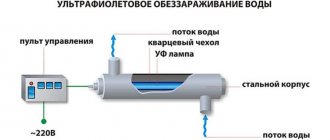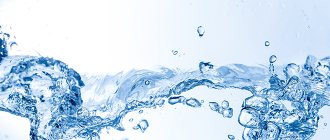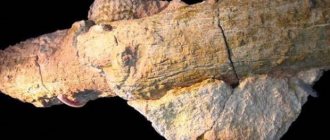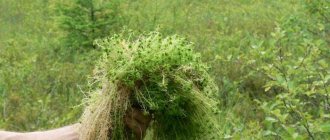Read before going into the desert! Endless sands, lack of moisture, hot air, bright, skin-burning sun - all these are signs of a merciless desert. But even in such an area you can find the most common element on the planet - water. The ability to find water will allow you to survive in the desert for many days and even weeks, while its absence will lead to death from dehydration within three days.
How to find water in the desert
The most realistic places for the accumulation of life-giving moisture are in river beds, on their bends and in lowlands. You should also look for water in the desert in the hollows on the leeward side of the dunes. It’s worth noting right away that success in this matter does not come immediately. In addition, you will need to make an effort to “get to the bottom” of the aquifer.
You can dig in the desert with your hands or any available tool - a spoon, fork, knife, stick, other metal and hard plastic objects. Typically, the aquifer is located in the deepest depression between the highest dunes at a depth of one to two meters. First, the traveler will see a wet horizon, and after some time water will appear in it.
If you are in a desert among the mountains, then the aquifer may come to the surface on steep slopes. Water can also be located in deep depressions. The presence of vegetation in such places directly indicates the presence of life-giving moisture. In addition, in the mountains, water sometimes accumulates under a thin layer of topsoil. The presence of moisture is also indicated by drops on the rocks, which are a sign of evaporation.
Other factors that can help in finding water include:
• The presence of midges that swarm over one place after sunset. • Presence of vegetation – grass, tree bushes. • Presence of a single date palm (true in Africa) or poplar (Populus diversifolia).
In many places in the deserts there are artificial wells designed to support the strength of travelers. They are needed by caravans, shepherds, and lost wanderers. It is worth carefully examining the surrounding area in search of such a place, since wells are usually carefully hidden from the sun and are invisible over long distances.
If you come across a caravan trail, such a well can be found by:
• The presence of side paths. • The presence of animal trails – trampled paths with droppings. • By the presence of a pile of stones and branches with a sign in the form of matter or bone. This is "Obo" (in Central Asia) - a sacred sign, often indicating the presence of a source of water.
How to find water in the desert
Life of animals and plants without water
In deserts, where there is almost no water, plants and animals have developed unusual survival strategies, managing to obtain and store moisture in different ways.
The desert in the center of Saudi Arabia seems completely lifeless. But that's not true. She is full of life. In the middle of the day, its inhabitants disappear from view, fleeing the scorching sun. However, with the onset of evening coolness, they come out of their hiding places, and the desert is transformed.
Long roots and small leaves
Plants have developed different ways of surviving in the desert. Some, including wild watermelons, develop broad root systems to collect water from as large an area as possible. Others, such as desert acacias, have roots that go down to a depth of 30 m, absorbing water from the bowels of the earth. Some desert plants can rest as seeds for years, and after heavy rain they can germinate, bloom and form new seeds in a matter of days. Velvichia amazing, found in Namibia and southern Angola, absorbs the dew that falls at dawn with two unusually long, flat leaves. These leaves continue to grow throughout the life of the Welwitschia, gradually dying off at the ends and splitting into narrow ribbons (belts).
Other plants, especially members of the Euphorbiaceae and Cactus families, survive due to their ability to store water. Such plants are called succulents. Their leaves are small or absent, and their stems are thick and fleshy. Dense covers prevent the evaporation of water from tissues. Some succulents store water in their roots or fleshy leaves.
Sunstroke protection
The arid antelope and three species of oryx antelope live in the arid regions of Africa and the Middle East. These ruminants with long, hollow horns obtain water by feeding on the stems, roots and tubers of succulents, and by licking the dew that forms on the leaves of plants in the morning. The microflora of their stomachs is capable of breaking down cellulose into simpler compounds, from which water is formed in the tissues. The excrement of desert antelopes is completely dry.
Read: African ostrich
Addaxes are particularly tolerant of dry conditions. They can go without water for months, receiving the necessary moisture exclusively from plant food. In addition, addaxes sense sources of water located near the surface of the soil, and sometimes get to it by digging out the ground with their hooves. They also have the amazing ability to find areas of the desert that have turned green after short rains.
These animals never overheat even under the scorching sun. Their light fur reflects its rays, and a well-developed network of capillaries cools the brain. Such devices reliably protect desert antelopes from sunstroke.
Dorcas and other gazelles, less well adapted to arid living conditions than oryxes and adcas, make long migrations in search of water and green pastures.
Cool shelters
It is especially difficult in deserts for small mammals - gerbils, jerboas, African fennec foxes and desert hares. The animals run the risk of quickly dying under the scorching sun from dehydration. Therefore, they wait out the hot daytime hours in deep burrows, and only go out to search for food at dusk or at night. During the hottest months of the year, some small mammals even hibernate. At this time, their body temperature drops, metabolism slows down, and the body can go without water and food for a long time.
Read: Apatosaurus (brontosaurus)
Long hind legs allow jerboas to escape from danger in large, fast leaps, almost without touching the hot sand. The animals' front legs are short but strong. With their help, jerboas dig holes and strip off the plants they eat.
Thank you, I don't drink!
Some gerbils and jerboas do not drink water at all. They extract all the moisture necessary for the body from food, digesting dry stems and seeds of plants and oxidizing the resulting carbohydrates in the process of cellular respiration. As a result, carbon dioxide is produced, which the animals exhale, and water, which the body uses extremely sparingly. Their urine is very concentrated, and their droppings are very dry. The sweat glands of these rodents are reduced, so the animals do not lose moisture through sweat. Thanks to the exhaled water vapor, their burrows are quite humid. Desert rodents begin to reproduce only with the onset of rains. When the desert is covered with greenery for a short time, the females gorge themselves on succulent plants to compensate for the cost of water for feeding the cubs with milk.
As for predators, such as fennec cats and wild desert cats, they obtain moisture from the flesh of their victims. The fennec usually hunts small rodents, birds, insects and lizards at night, and during the day sleeps in a hole that it digs in sandy soil.
A drop is enough
In the mornings, thick fog falls on the Skeleton Coast in Namibia - the only source of moisture for the inhabitants of these very dry places. It is constantly formed as a result of the mixing of cold air blowing from the Atlantic Ocean with the hot breath of the Namib Desert, which stretches along the sea coast. When the fog settles, small drops of dew remain on the leaves of plants. This moisture is quite enough for darkling beetles, desert spiders and some lizards to live.
Read: Allosaurus
You can often see a beetle crawling along the sand, holding a large drop of dew between its legs. It formed on its hard elytra and rolled down to its feet. At dawn, the beetles abruptly raise the back of their body upward and collect dew on their elytra. The waxy layer on the surface of the integument of many desert insects prevents the evaporation of moisture from the body.
Water from fat
Bactrian and dromedary camels produce very concentrated urine. They lose only 1 liter of water per day through urine. These animals have accumulated fat in their humps, which, when burned, provides the body with energy and moisture. A camel uses up its fat reserves when it is acutely short of food and water: fat turns first into carbohydrates, and then into carbon dioxide and water. Having reached a reservoir after a grueling journey, a camel can drink up to 120 liters of water in one sitting. It is stored in the lining of the stomach. A camel easily tolerates dehydration: without receiving water for a long time, it can lose up to 20% of its weight without harm to its health (for comparison: a person who has lost only 12% of his weight due to dehydration will inevitably die).
How to make life easier when there is no water
In addition to aquifers and springs in the desert, ordinary dew can help survive. To do this, before dawn, you need to collect and place smooth stones together. As a result, moisture condenses on them and after dawn it will help at least slightly support the life support of the body.
If you come across salt lakes or a small body of water, you should not drink the water from it. A large amount of minerals will cause stomach upset, which will lead to even greater moisture loss. But you can moisten your clothes and bandana with this water, which will reduce moisture loss.
If you find yourself in a desert in winter, frost will help you get fresh water from a salt lake. To do this, pour water into any container, wait until it freezes more than half, and pour out the rest. If the water is still too salty, the procedure should be repeated.
Formation of water in the desert
Where does water come from in deserts that can create individual oases, the size of which can extend for many kilometers? Such questions often occupy people who see lush thickets of palm trees for the first time in the middle of hundreds of kilometers of desert sand. Strange as it may sound, water has always existed in the underground horizons of the desert, despite the fact that it got there in various ways.
1. The most common way for water to enter the underground storage areas of the desert is through the pre-existing extensive network of water arteries and basins, until the movement of the continents changed the angle of inclination of the earth’s surface, after which the flow of water by gravity stopped. As a result, the water partially evaporated and partially remained deep in the earth, where numerous galleries and storage tanks were dug over the years of water flow. Such water remains conserved for many millennia, only occasionally rising to the surface. Outlets of conserved water to the surface are formed in the areas of the least deep underground storage facilities. The depth of the soil in such places can vary from 40 to 5 meters.
2. Part of the underground water was formed in that distant period when the existing soil surface was the bottom of the sea, ocean, freshwater lake or river. It was during those times that the soil at the bottom was mixed with water, creating mixtures of water and residual rocks such as sand or clay. The mixtures filled uneven surfaces, retaining a large amount of water in their composition. Depending on the bottom of which body of water was soil, the water in it turned out to be fresh or salty. Surfaces that were previously the bottom of seas, for example, the Aral Sea or the Caspian Sea, are rich in such waters.
3. Some of the wet sand is formed as a result of condensation of water vapor from the atmospheric air. No matter how small the amount of water dissolved in the air atmosphere is, it is present in the air, and according to the laws of physics, it condenses on surfaces when the temperature difference between the surface and the atmospheric air reaches 6 degrees. This most often occurs near rock ledges, when not yet heated water vapor settles on the heating stones. The volume of condensation formed is so high that it soaks into the ground, gradually creating wet sand. Some species of plants grow on such sands along the rocks and large representatives of the animal world can live. Thanks to the formation of water condensate, rocky deserts form their own flora and fauna, accustomed to life with minimal water consumption.
The presence of water in deserts is the main condition for the existence of life forms, so the attitude towards it must remain extremely thrifty, for example, growing only drought-resistant species of plants and animals, as well as developing only such types of industry that do not require the consumption of large amounts of water.











